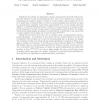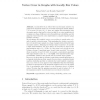69 search results - page 5 / 14 » The cover time of sparse random graphs |
116
click to vote
CORR
2011
Springer
14 years 4 months ago
2011
Springer
Dynamic graphs have emerged as an appropriate model to capture the changing nature of many modern networks, such as peer-to-peer overlays and mobile ad hoc networks. Most of the re...
APPROX
2005
Springer
15 years 3 months ago
2005
Springer
We consider the problem of finding a maximum independent set in a random graph. The random graph G, which contains n vertices, is modelled as follows. Every edge is included inde...
FSTTCS
2009
Springer
15 years 4 months ago
2009
Springer
Partial Cover problems are optimization versions of fundamental and well studied problems like Vertex Cover and Dominating Set. Here one is interested in covering (or dominating) ...
131
click to vote
ICALP
2011
Springer
14 years 1 months ago
2011
Springer
In [13], Erd˝os et al. defined the local chromatic number of a graph as the minimum number of colors that must appear within distance 1 of a vertex. For any ∆ ≥ 2, there are ...
SPAA
1993
ACM
15 years 1 months ago
1993
ACM
We give tight bounds on the parallel complexity of some problems involving random graphs. Speci cally, we show that a Hamiltonian cycle, a breadth rst spanning tree, and a maximal...


